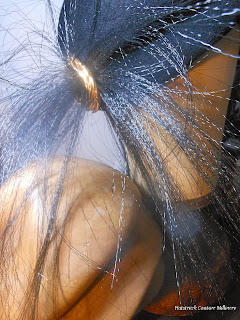 Sorry to disappoint some of you, but there are no hats in this post. Instead I thought I would share my first completed Christmas gift, a crocheted rope scarf. For those of you that don't knit and/or crochet and have no interest in these crafts, please feel free to change the channel. For those of you that do, stay tuned.
Sorry to disappoint some of you, but there are no hats in this post. Instead I thought I would share my first completed Christmas gift, a crocheted rope scarf. For those of you that don't knit and/or crochet and have no interest in these crafts, please feel free to change the channel. For those of you that do, stay tuned.Although I've been knitting and crocheting since the age of 10, I'm no expert. I can read patterns but I prefer free-from crocheting and knitting. I have to admit that I'm more partial to crocheting because, for me, correcting mistakes is so much easier, just unravel and proceed on. Plus, I prefer to be in a meditative state when I'm crafting; I don't want to think about what I'm doing. Whatever I end up with is exactly what you will be getting.
I made similar scarves last year, but this one was made using a different method. Last year I made rope scarves using both Crocheted I-Cord and Knitted I-Cord techniques, both of these methods are found on my Crochet, Knitting and Tutorials Board on Pinterest. I preferred the knitted I-Cord to the crocheted one. If you decide to make this scarf using one of these methods, make a swash using both methods and choose the one you are most comfortable with. Also, please note that the thickness of the cord depends on the number of chain stitches you use to start circular tube, the thickness of the yarn, and the size of the needle. If you do not crochet and would like to learn how to, I've created a query link for beginning crocheters here on YouTube.
 How I Made This Scarf--My Yarn Box Runneth Over!
How I Made This Scarf--My Yarn Box Runneth Over!I really wanted to make a thicker, faster, and easier rope scarf this time around; so, I decided to crochet in-the-the-round rather than using one o the I-Cord techniques. If you are a crocheter, this scarf will be extremely easy and fast to make. I chose a chunky (they called it chunky; I refer to the really thick, thick yarn as chunky) and a large crochet needle (10mm--[N]) . Again, the same applies here as mentioned above about the thickness of the I-Cords, it all depends on the number of chain stitches you use to start the circular round, the thickness of the yarn and the needle size. Proceed as follows using the yarn, number of chain stitches, and needle size of your choice:
1. Chain 5 stitches and slip stitch the ends together.
2. Insert needle into the second chain.
3. Single crochet into each chain in the round (just go around and around) until you reach your desired chain length.
4. To finish off scarf when desired length has been achieved, cut thread leaving approximately seven inches, pull thread through last crocheted stitch and pull tight, but gently.
5. End the rope by threading the excess thread onto a wide eyed needle and sewing in the round until the rope (tube) has been closed and secure.
6. To hide some of the excess thread, work it through the stitches, and finally cut the excess thread off. If you don't crochet and you are trying this project, you may want to follow the beginner's link above.
That's it! I collect vintage brooches, so I just temporarily put one onto the scarf to dress it up for the shoot. I may even keep this one for myself because the color looks great on my skin tone. Enjoy!















